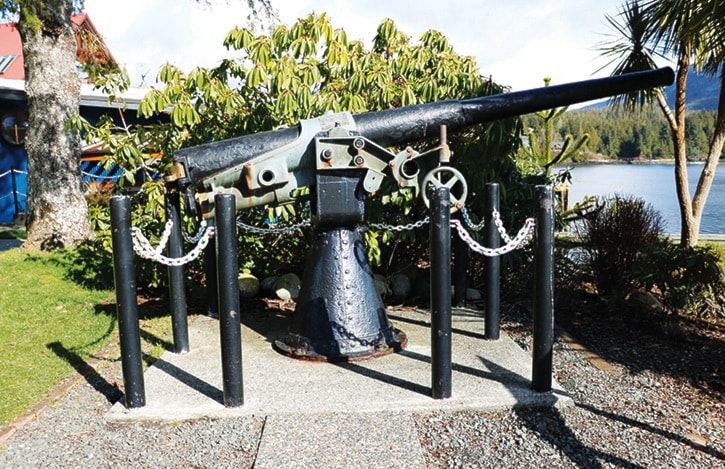A fascinating dive site featuring a historic Canadian vessel could soon reopen to scuba enthusiasts as Canada’s Department of National Defence is preparing to remove the unexploded ammunition that forced its closure.
The ammunition was used in a 12-pounder gun that now sits across from Ucluelet’s Municipal Hall.
That gun spent its career affixed to the HMCS Thiepval, which is resting roughly 15 metres below the ocean’s surface against the reef that ended its career between Turret Island and Turtle Island on Feb. 27, 1930.
“The crew all got off the ship safely [but] they couldn’t salvage the ship and it sank to the bottom and that’s where it still sits today,” Pacific Rim National Park resource conservation manager Renee Wissink told the Westerly News.
Because of the West Coast’s turbulent waters, the Park is rife with shipwrecks, but the Thiepval is a rare sight around the calmer and more protected Broken Group Islands.
“It’s probably one of the more prominent ones in the Broken Group Islands,” Wissink said.
“Down the West Coast Trail, there’s quite a number of them, or at least remnants of them. The most famous being the Valencia, which was one where there was a great loss of life and really sparked the whole debate and began the lifesaving trail that eventually became the West Coast Trail that’s in the Park today.”
The Thiepval was built in Kingston, Ontario, and launched in 1917 as part of a WW1 battle class armed trawler fleet.
“There was this growing U-Boat threat, particularly against merchant shipping, and that’s what they were meant to patrol against,” Wissink said. “They were coal fired. They moved around at about 10 knots and they were armed with a single, 12-pound, three-inch, main gun on the front and then depth charges of course.”
In 1919, the Thiepval was transferred to Esquimalt. Her depth charges were removed, but her main gun remained.
“That’s the big gun that sits in the town square in front of the Ucluelet Aquarium today,” Wissink said adding the gun was retrieved long before the Pacific Rim National Park was established. “That’s the most visible aspect that people in Ucluelet, and the region, would know of Thiepval.”
The Thiepval’s West Coast career was spent on fisheries patrols, custom inspections, policing and search and rescue operations.
“It had quite a long storied history on both of Canada’s coasts, playing important government roles. It is considered an important part of Canadian history, albeit 12-17 metres below the surface depending on the tide,” Wissink said adding all ship wrecks within the Park Reserve are protected. “They become historical artefacts.”
He added the site is popular among scuba divers because the sheltered nature of the area has protected the vessel from erosion and created an attractive habitat for marine life.
“It sits in relatively calm waters. The water is generally clear particularly early in the season. The reef already was creating quite a bit of diversity for various fish species but Thiepval has added to that,” he said.
“People like to dive on it because it’s interesting. It creates a diverse habitat for undersea wildlife.”
Wissink said Canada’s Department of National Defence shut the area’s scuba activity down roughly four years ago, after learning about the presence of unexploded ammunition, which it plans to remove this summer.
“There was ammunition stored on the ship so some of that ordinance, which is now considered unexploded ordinance, is potentially still dangerous to any divers who may touch it or try to move it,” he said. “You can drive over the surface of course, with your boat, but it is closed to diving to protect public safety and ensure nobody goes down and is injured as a result of these ordinances being there; as remote as that even might be.”
He chalked up the amount of time it’s taken for the DND team to remove the explosives to the complicated process of retrieving, and disposing of, underwater ordinance.
“It’s not just a matter of bringing it to the surface but what you do with it then,” he said. “These things have to be disposed of and rendered safe without driving them through communities.”
He is excited to see the site reopened to divers.
“Everything else will remain as is,” he said. “Once the ordinances have been removed, and once DND gives us the clearance that it’s safe, then we will be opening it again to recreation diving.”
He said the vessel doesn’t pose an environmental threat.
“We’re talking since 1930 that this one’s been down at the bottom. Essentially, what’s left there is steel and wood and a hodgepodge of artefacts,” he said. “Things that we would really be concerned about with derelict vessels these days, like the diesel and the lubricants, are long gone from Thiepval.”
